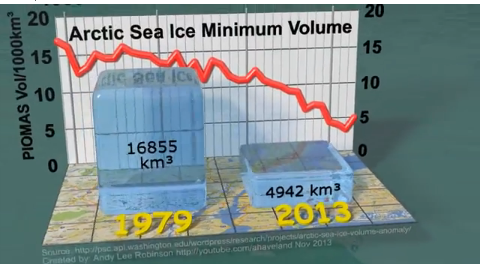
Artic sea ice volume has dropped far faster than coverage. In September the ice that remains is down by nearly 80% from its volume in 1980. At current pace of volume loss, the first ice-free Arctic day could come in just a few years. | Sea ice volume is a measurement of ice extent and its thickness. Understanding how fast the ice is being depleted by volume is crucial to working out how quickly we are approaching an ice-free Arctic summertime because thinner ice can be more vulnerable to future melting. As one expert noted, “there comes a point when large parts of the ice pack become so thin that it doesn't matter what the weather does…the train keeps chugging along, even when the weather isn't so great for melt”.
As with sea ice extent, volume appears to be in sharp decline in the Arctic. Although ice volume naturally increases and decreases during the seasons, scientists using the Pan-Arctic Ice Ocean Modelling and Assimilation System (PIOMAS) have identified that the amount of ice has been steadily falling since the 1970s.
In addition, the link between disappearing ice and temperature in modern times is now becoming much clearer. NOAA has said that the Arctic “has reached a new state…characterised by less sea ice (both extent and thickness),” adding that “the decline in total sea ice extent has been accompanied by an unprecedented loss of old, thick multiyear ice.”Or, as one commentator noted, Arctic sea ice loss is now “being driven by human emissions.Click here for the source |